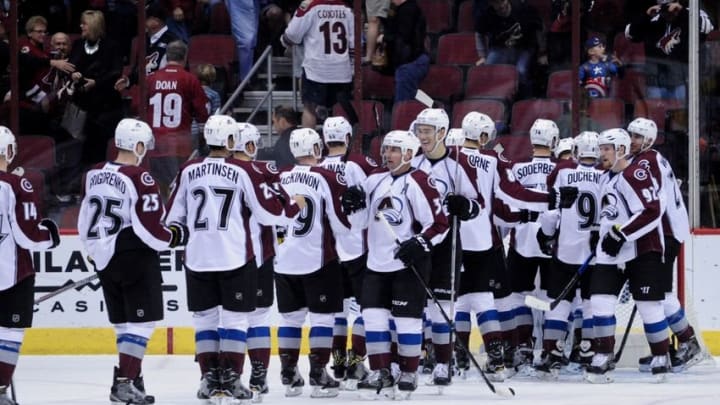Despite a pool of exciting young talent, the Colorado Avalanche are under-performing. Can chemistry between team members be an issue?
How can the Colorado Avalanche be dead-last in the Central Division when the front offices specifically utilized analytics to augment the team? Not only did GM Joe Sakic pick up fancy stats darlings such as defenseman Patrick Wiercioch, the team even hired an analytics expert.
You could point to the inconsistencies in the Avalanche’s play. They don’t get good enough goal tending on a regular basis. They still allow too many shots on goal. The defense is shoddy, and the forwards don’t score enough.
On the other side, you consistently hear the argument that the young core is so talented. The Colorado Avalanche feature some bright, young players. What can the problem be?
Let me acknowledge that analytics can be interesting — you can get some insightful information from crunching numbers. And if you’re playing baseball, fancy stats might actually help you win the game.
That’s not how it works in a fast-paced game such as hockey. This is a game in which an own-goal can mean victory. (Colorado Avalanche vs Winnipeg Jets, OT.) This is a game in which a goalie can plop his padded butt on the puck to save the goal, or knock the puck into the net with his padded butt.
Never mind all that — this is a FAST game. Maybe a computer can crunch numbers faster than Nathan MacKinnon can skate, but people on the sidelines can’t get the analysis out on the ice fast enough to make a difference. Analytics are for between games.
Chemistry is what counts during games. And it appears the Colorado Avalanche are failing at it.
BSN Avalanche attended yesterday’s practice at Family Sports Center in Centennial. (All practices are open to the public, by the way.) During practice, BSN observed the following:
Beauchemin absolutely laying into the team as they stretch. Slams his stick on the ice and says "Show that you f****** care!"
— DNVR Avalanche (@DNVR_Avalanche) November 30, 2016
Now, defenseman Francois Beauchemin is one of the newly-minted alternate captains for the Colorado Avalanche. I’ve observed before his willingness to speak up loudly when he doesn’t see what he likes. Notably last year he yelled at defenseman Erik Johnson when the latter wasn’t in a position to Beachemin’s liking.
This kind of scene happened a lot at practice. Several times over the last two years, witnesses observed then-coach Patrick Roy screaming at the players. He was often yelling that they shouldn’t act “brain dead.”
However, longtime Avs insider Adrian Dater made an interesting observation attached to the BSN tweet:
Now do people believe me when I said there were some chemistry issues with this team? https://t.co/HlhcjoVbIV
— Adrian Dater (@adater) December 1, 2016
I’d never heard Dater talk about chemistry problems within the team. However, it makes sense. How can the team have all the pieces in place yet not be able to succeed?
What’s especially frustrating is the team’s inability to score. The core is built around four players with excellent scoring ability — forwards Matt Duchene, Nathan MacKinnon, Gabriel Landeskog and defenseman Tyson Barrie. Erik Johnson is expected to pot a few in, too.
Now, I’ve been talking about the need for a team psychologist for a while now:
Related Story: Do the Avs Need a Therapist or a Drill sergeant?
Related Story: Are Players Choking During Games?
My proposal is based on the fact that Matt Duchene has talked openly about seeing a sports psychologist to help him get out of his own head. And what’s telling is that Duchene is essentially the only player on Colorado who never disappears on the ice.
More from Mile High Sticking
- Could Colorado Avalanche move on from Pavel Francouz next offseason?
- 4 goalies to replace Pavel Francouz if he has to miss time
- Colorado Avalanche make sneaky signing with Tatar
- Colorado Avalanche captain Gabriel Landeskog could return in 2023-24 playoffs
- Colorado Avalanche rookie face-off tournament roster
However, this idea about chemistry isn’t about individuals. When we look at the golden Why Not Us season (2013-14), pundits claimed the Colorado Avalanche’s success was unsustainable because the players were performing greater than they were.
What was not discussed was why. And now maybe we have a clue — chemistry. You see it with defensive pairings — when two guys are clicking, they can operate as a single unit no matter what they’re doing. You see it, too, with great scoring lines.
The Colorado Avalanche didn’t have as high-caliber talent in 2013-14 as they do now — they had really young talents and some grinders to support them. They also had a player-hero for a coach. That and the known chemistry between players such as Duchene-Paul Stastny-Ryan O’Reilly and Erik Johnson-Jan Hejda helped them succeed.
Building a successful NHL team can’t be only about analyzing the stats. Because of its speed, hockey is much more a team game than baseball or even football or basketball. There simply isn’t time to stop and analyze.
Instead, players have to rely on their personal instincts. They also have to think with one mind that happens to consist of five parts (the five skaters). When you see a team really jamming — connecting all the passes, implementing one-timers, etc. — that’s what’s going on.
And that’s not what’s happening with the Colorado Avalanche right now. Instead, they’re skating around as five individuals at a time. And that’s how you end up dead-last in the Central Division despite having exciting young talent on your team.
